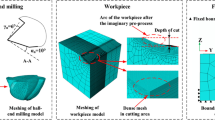Abstract
Mill turning is a process applied in the milling of a curved surface while the workpiece rotates around its center. Depending on the eccentricity of the tool, when a flat-end mill tool performs a curved trajectory perpendicular to the rotation axis of the tool, its bottom part is engaged in removing material. In order to optimize the process, the cutting force needs to be predicted. Hence, in this work, an approach to simulating the cutting force in mill turning is presented. The case of non-eccentricity of the tool is considered. The undeformed chip geometry is modeling as a function of the tool engagement considering the process kinematics. Experiments were conducted on a five-axis machining center enabling the measurement of the X–Y and Z components of the cutting forces. In order to verify the influence of the bottom part of the tool on the cutting forces, experiments were carried out using three different cutting depths. Numerical cutting simulations and experimental test results are compared to validate the proposed approach.
Similar content being viewed by others
References
Milling Technical Guide, Sandvik Coromant, http://www.coromant.sandvik.com. Accessed November 2010
Dietzel R (2001) HSC-Tangentialdrehfräsen erzeugt hohe Oberflächenüte. Maschinenmarkt 6:24–26
Savas V, Ozay C (2007) Analysis of the surface roughness of tangential turn-milling for machining with end milling cutter. J Mater Process Technol 186:279–283
Schulz G, Spur G (1990) High speed turn-milling—a new precision manufacturing technology for the machining of rotationally symmetrical workpieces. CIRP Ann Manuf Technol 39(1):107–109
Kopač J, Pogačnik M (1997) Theory and practice of achieving quality surface in turn milling. Int J Mach Tools Manuf 37:709–715
Lisboa ES (1996) Fresotorneamento em Aços Endurecidos (Mill-turning of hard steels), Ms Thesis (in Portuguese), Faculdade de Engenharia Mecânica, Universidade Estadual de Campinas, Campinas, Brazil.
Choudhury SK, Mangrulkar KS (2000) Investigation of orthogonal turn-milling for the machining of rotationally symmetrical work pieces. J Mater Process Technol 99:120–128
Pogačnik M, Kopač J (2000) Dynamic stabilization of the turn-milling process by parameter optimization. Proc Inst Mech Eng B-J Mech Eng Manuf 214:127–135
Neagu C, Gheorghe M, Dumitrescu A (2005) Fundamentals on face milling processing of straight shafts. J Mater Process Technol 166:337–344
Martellotti ME (1941) An analysis of the milling process. Trans ASME 63:667–700
Altintas Y (2000) Manufacturing automation—metal cutting mechanics, machine tool vibrations, and CNC. Cambridge University Press, Cambridge
Araújo AC, Silveira JL (1999) Models for prediction of instantaneous cutting forces in end milling. In: Proceedings of the 15th Brazilian Congress of Mechanical Engineering. November 22–26, São Paulo, Brazil.
Tlusty G (2000) Manufacturing process and equipment. Prentice Hall, Upper Saddle River NJ, USA
Denkena B, Tönshoff H-K (2003) Spanen: Grundlagen, 2nd edn. VDI, Berlin
Author information
Authors and Affiliations
Corresponding author
Rights and permissions
About this article
Cite this article
Martins Crichigno Filho, J. Prediction of cutting forces in mill turning through process simulation using a five-axis machining center. Int J Adv Manuf Technol 58, 71–80 (2012). https://doi.org/10.1007/s00170-011-3391-6
Received:
Accepted:
Published:
Issue Date:
DOI: https://doi.org/10.1007/s00170-011-3391-6




